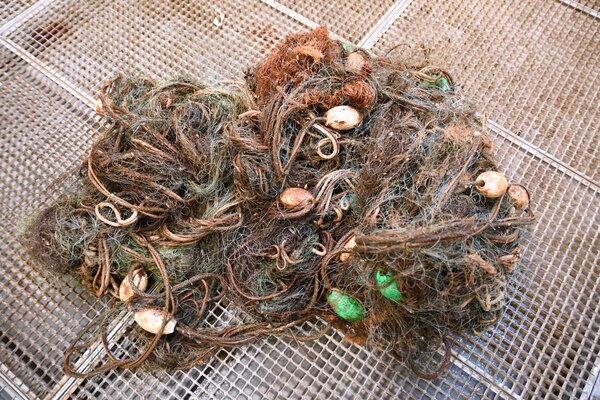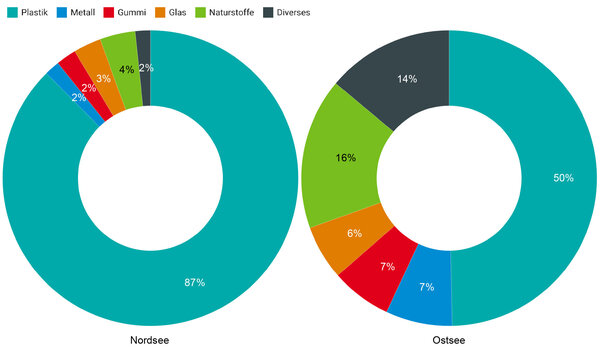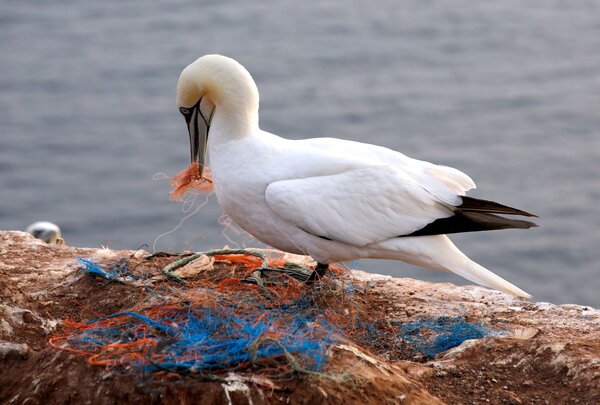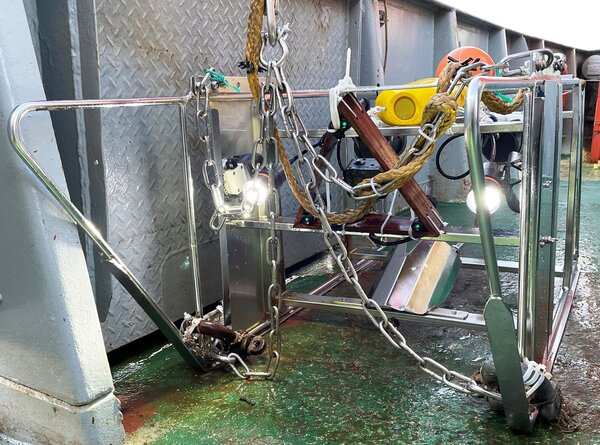Expertise
Litter in German marine areas
Ulrike Kammann | 03.01.2024
Marine litter is a global problem. A large proportion of marine litter lies on the seabed and is hidden from our view. The Thünen Institute is investigating how much and what kind of litter lies on the seabed in German marine areas using fishing catches and video recordings. The avoidance of litter is also an important topic.
Large quantities of marine litter have entered the oceans as waste from land, partly via rivers. However, a considerable proportion also comes from shipping or fishing and accumulates directly at sea. Plastic waste in particular is long-lasting and remains in the sea for decades before it breaks down into microplastics. These plastic particles are ingested by fish and other marine organisms and pose a potential risk. Larger pieces of plastic waste such as lines and nets are also risky: Organisms can become entangled in them and die. The marine litter load is therefore regularly monitored internationally.
The Thünen Institute is involved in this monitoring, e.g. as part of the European Marine Strategy Framework Directive (MSFD) and the regional marine protection conventions. At the Thünen Institute, however, we not only fulfil these monitoring tasks, but also take a comprehensive approach to the problem. Starting with the collection of data on the occurrence and composition of marine litter, through analysing its sources from fisheries, to the development of solutions for the future avoidance of marine litter from fisheries.
Standardised methods
There are internationally standardised methods for recording and investigating the quantity and composition of litter on the seabed. The Thünen Institute of Fisheries Ecology analyses macro-litter with a size of 2.5 cm or more in fishery catches within the German Exclusive Economic Zone (EEZ). The Thünen Institutes of Sea Fisheries and of Baltic Sea Fisheries fulfil sovereign obligations to monitor litter on the seabed by participating in international surveys such as the International Bottom Trawl Survey (IBTS), the International Beam Trawl Survey (BTS) and the Baltic International Trawl Survey (BITS).
In accordance with the current protocol of the International Council for the Exploration of the Sea (ICES), data on litter on the seabed is collected several times a year in defined areas within German waters during the cruises with the fisheries research vessel Walther Herwig III: In each fishing haul, the litter caught is counted, categorised, weighed and photographed. A sample is also taken from pieces of plastic waste and the type of plastic is determined in the laboratory using FTIR (Fourier transform infrared spectroscopy).
The amount of litter is related to the area covered by the net during the trawling period and is given in the unit of pieces of litter per km². Data on litter on the seabed from the various internationally coordinated bottom trawl surveys of the Thünen Institute are regularly reported to ICES, from where they are used for European environmental assessments of the North and Baltic Seas. The data is freely available there.
How much litter is found?
A total of 876 pieces of litter were found in fishery catches during 16 research cruises between 2013 and 2022. On average, the North Sea EEZ with 36.8 pieces of litter/km² shows a higher load than the EEZ in the Baltic Sea with 8.8 pieces of litter/km².
Plastic dominates the composition of litter in both marine areas. In the North Sea EEZ, the proportion of plastic litter on the seabed is 87 %, compared to 50 % in the Baltic Sea EEZ. The proportion of litter from fishing is significantly higher in the North Sea (approx. 60 %) than in the Baltic Sea (only approx. 20 %). When comparing the North Sea and Baltic Sea, however, it should be noted that different nets were used for fishing in the two seas.
Regional differences
The regional differences in contamination with litter on the seabed at the individual stations of the research cruises are clearly shown in the map. The highest mean values occur in the North Sea EEZ at the eastern, coastal station GB1. The seabed in the Baltic Sea is most heavily contaminated with litter at the westernmost station B01. In addition to the quantity, the composition of the litter also differs from region to region. In addition to the dominant material plastic, smaller amounts of litter made of metal, rubber, glass or natural materials are found. The composition of plastic litter in the North Sea and Baltic Sea EEZs also differs significantly: while fishing lines, monofilaments and plastic film are particularly common in the North Sea, synthetic ropes, plastic film and plastic bags are mainly found at the bottom of the Baltic Sea.
Floating plastic also sinks
The FTIR analysis of the polymers - i.e. the type of plastic - in the litter on the seabed of the North and Baltic Seas has shown that most of the plastic litter consists of polyethylene, polypropylene and polyamide. Most of the polymers identified have a lower density than salt water and should therefore float on the sea surface. Apparently, some of the plastic waste has sunk despite its original buoyancy - presumably due to biofouling. Over time, therefore, the lighter types of plastic also accumulate on the seabed.
The role of fisheries
Some of the marine litter comes from fishing. In the North Sea EEZ, this amounts to 21.8 pieces of litter/km² or around 60 % of the litter on the seabed. In the EEZ in the Baltic Sea, it is only 1.7 pieces of litter/km² or approx. 20 % of the litter.
Thin, colourful plastic threads are particularly common in the North Sea. These are usually so-called dolly ropes, a polyethylene abrasion protection for bottom trawls. They are intended to protect the trawl and tear off in the process. In a research project, the Thünen Institute has developed alternatives to make dolly ropes superfluous and thus reduce the overall amount of waste. Joint tests with fishermen have shown good results. Based on these findings, politicians are in favour of a Europe-wide ban on dolly ropes. A large part of fishermen is also in favour of such a legal regulation.
Lost nets or net parts are a recurring topic of discussion. However, they are relatively rarely caught in the German EEZ.
Angling
Litter from recreational fishing also reaches the Baltic Sea. In 2018, the Thünen Institute interviewed anglers for the first time. 6 % stated that they had lost parts of their fishing equipment, e.g. artificial lures, lead weights, thin fishing lines, bend lights or hooks. The vast majority of the Baltic Sea anglers surveyed were aware of the litter problem and are prepared to help reduce the environmental impact by using environmentally friendly alternatives such as lead-free weights. In beach litter monitoring on German coasts, fishing tackle lost by anglers hardly ever appears. A large proportion of lost or broken fishing gear is likely to sink to the seabed and not wash ashore, partly due to its heavy weight.
Supplementary visual methods
Overall, only a few pieces of litter can be found per area in the German EEZ using fishing catches. It is known that net hauls underestimate the amount of litter on the seabed. Nevertheless, due to the consistent, standardised method, both temporal trends and the composition of litter can be clearly tracked.
Visual methods are better suited to getting closer to the absolute numbers of litter on the seabed. The Thünen Institute has recently started working with a video sledge. It is equipped with spotlights and a camera and is towed directly over the seabed. In the process, film recordings are made in which the waste can be seen. The videos show 17 to 81 times more litter per km² of seabed than the fishing catches - even though particularly small pieces of litter are difficult to recognise in the video.
The question of whether litter on the seabed in concentrations such as those found in the German EEZ represents a relevant problem for organisms remains unanswered. Nevertheless, litter from fishing sources in particular bears a risk.
The avoidance of litter - especially litter from fishing - is therefore essential. The collection of data on marine litter, particularly using visual methods, also remains important, for example to track the effectiveness of targeted litter prevention measures.
More Information:
- Thünen à la Carte 13Environmental contamination: Litter in German marine areas (6 p., in German)



![Regionale Unterschiede von Müll am Meeresboden (blau) und des darin enthaltenen Mülls aus der Fischerei (grün) [Müllteile/km²] an ausgewählten Stationen in der Nord- und Ostsee Karte der Nordsee und Ostsee mit Angaben zur Menge an Müll am Meeresboden an ausgewählten Beprobungsstationen.](/media/_processed_/8/5/csm_Muell_Muellteile_pro_km2_2_e46b31e147.png)







